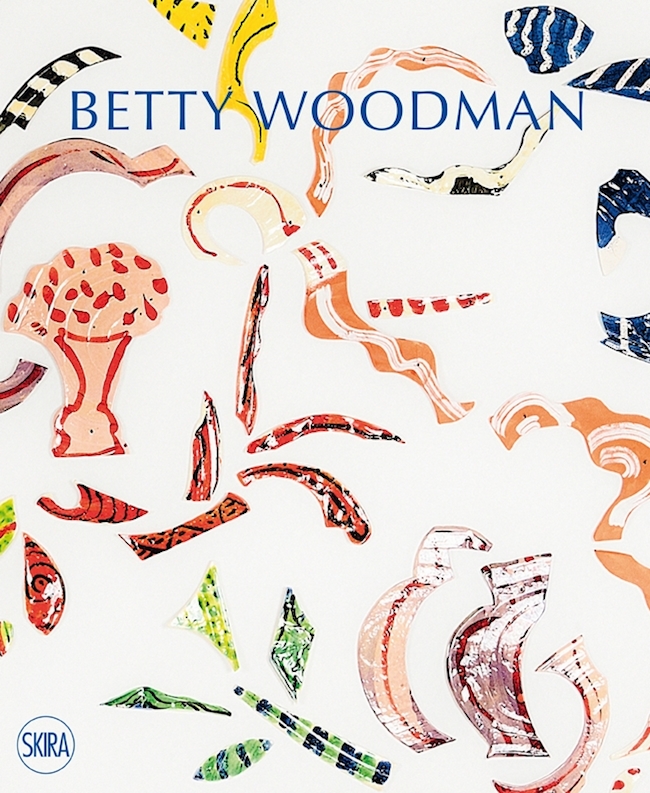Betty Woodman/
Foreword by Jeanne Greenberg Rohatyn
with an interview between Betty Woodman and Barry Schwabsky
Skira Editore, Italy , 2014
Softcover monograph, 104 pages. 73 illustrations. 11 x 9 inches
Transition is always a strange process. Breaking out of what we once were, often not even knowing to what end, we find parts and pieces that we can’t separate ourselves from while, at the same time, we tend to generate an excess that falls more often to the cutting room floor.
Betty Woodman is in a state of transition, but she is making use of every scrap, every piece of the cocoon she’s breaking free from, and the effect is worth not only a great deal of attention, but also some deep reflection.
In recent years or, perhaps better still, since her show The Art of Betty Woodman at The Met in 2006, a retrospective of her long career, Woodman has been turning to the medium of painting. She has gone from her bilious and iconic pillow vases to something startlingly different.

Betty Woodman, Grand Gesture, 2011, glazed earthenware, epoxy resin, lacquer, acrylic paint, 38 x 40 x 8 inches
The majority of her recent works, which the catalog aims to present, are flat and presented upon the wall or floor, or as standing double sided sculptures. These fill the gap in time between the book produced for her show at the Met and her current place of artistic output.
An aspect of this work is that, unlike the traditional medium of painting where a canvas, with its defined shape and space, the platform used is clay. So, unlike a canvas, what Woodman doesn’t want to use for her piece she cuts away, but still fires and keeps as scrap. This process is quite unique, in my mind, and represents something astonishing; Woodman, like a painter with their canvas, is unable to discard her alternate canvas, the slabs that she rolls out of her clay. In terms of a metamorphosis or, even, an exodus from one medium to another, this is an intriguing practice and one that raises many questions whether or not there are answers to find.
The scraps themselves are repurposed as wallpaper, rugs or the nonfunctional dishware for a table; illusion is the outcome of Woodman’s new direction. Then again, maybe it isn’t a new direction, “That’s what the history of ceramics has been, at lest in the western world: there’s a form, and then the way you paint on it changes the way you perceive it,” she tells Barry Schwabsky in an interview near the back of the book.

Betty Woodman, My House, 2014, glazed earthenware, epoxy resin, lacquer, acrylic paint, canvas, wood, 80 x 84 x 10 inches
Woodman is playing with this meaning throughout her recent works. She takes the form, the clay itself, and repurposes it as a canvas for painting two-dimensional works. What’s funny about this is, while she says that she’s pulling away from ceramics and tending towards painting, her works are often of two-dimensional teapots and, in the case of the double-sided sculptures, abstractions on one side and nudes on the other. The nude, as always, is a strong reference to surface, shape and form while the abstract paintings serve as an anchor to painting’s practice in the 20th century.

Betty Woodman, Tulip Vases/ Yellow Room, 2010, glazed earthenware, epoxy resin, lacquer, acrylic paint, canvas, 96.6 x 84 x 12 inches
This duality is either brilliant or the necessary outcome of ceramics moving back into the art world alongside paintings in fine art museums, galleries and publications; her work is a merger and is something like a historical nexus of past ideas and the current times.
Betty Woodman as a catalog is spectacular. Those who put it together had the difficult task of representing Woodman’s pieces from two different perspectives. In the case of Woodman’s two-sided sculptures the work is displayed on facing pages so that both sides can be considered. Various studio photographs are scattered throughout the opening pages of the book, they are well selected and, as always, a good, if too brief, look into the studio of an artist.
Also of particular interest are the wonderful two-page spreads of Woodman’s work as it was displayed at Salon 94 in various installations between 2011 and 2013. They give a sense of how she is expanding beyond clay and, even, painting and is moving into the territory of something more expansive; gallery scale installation, which would seem a natural next for this metamorphic artist.
Read our post about the new Woodman exhibition at David Kordansky Gallery.
Christopher Johnson is CFile’s Book Reviewer
Any thoughts about this post? Share yours in the comment box below.


Betty Woodman, The Rainbow (front and back), 2011, glazed earthenware, epoxy resin, lacquer, acrylic paint, 37 x 28 x 7 inches

Add your valued opinion to this post.